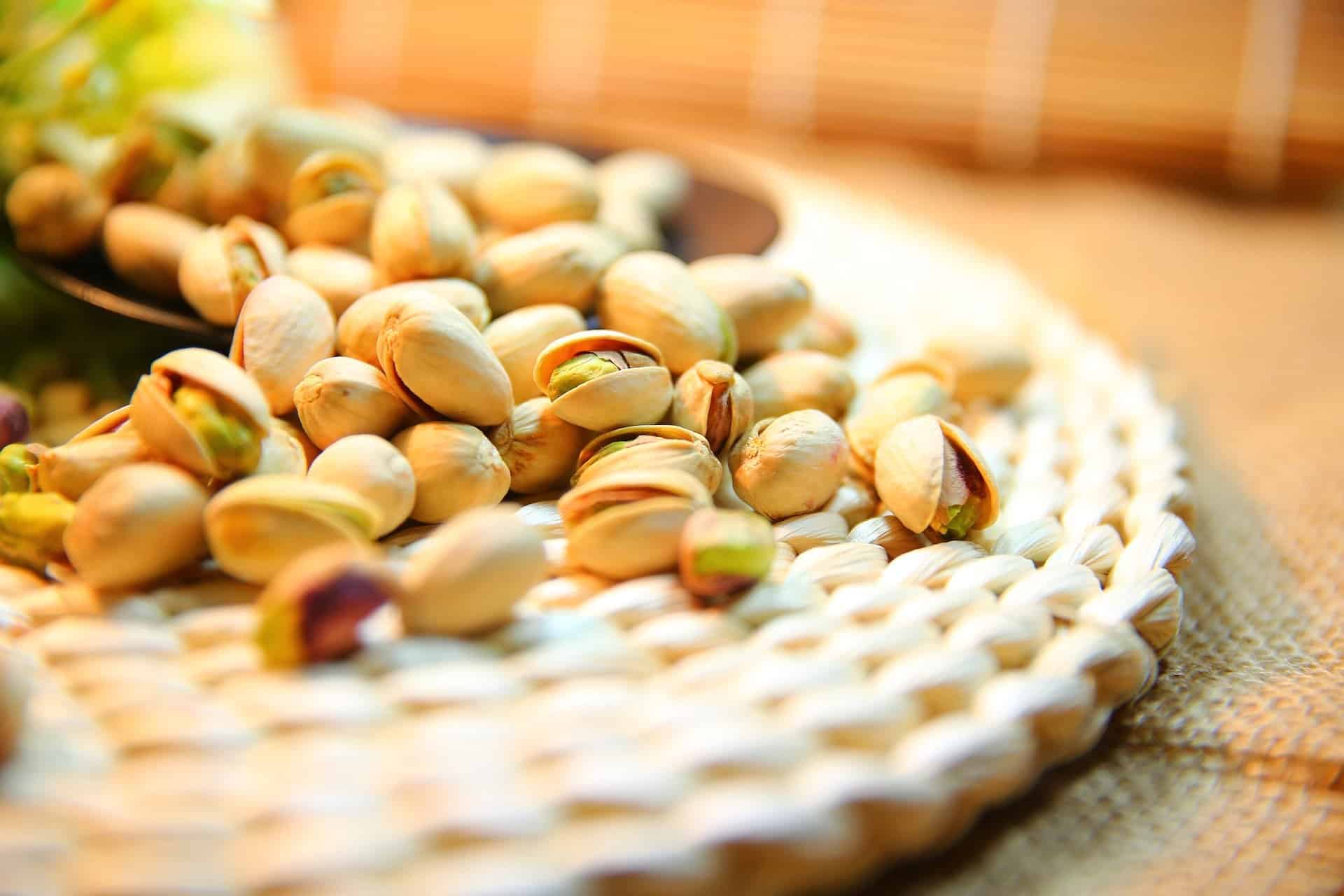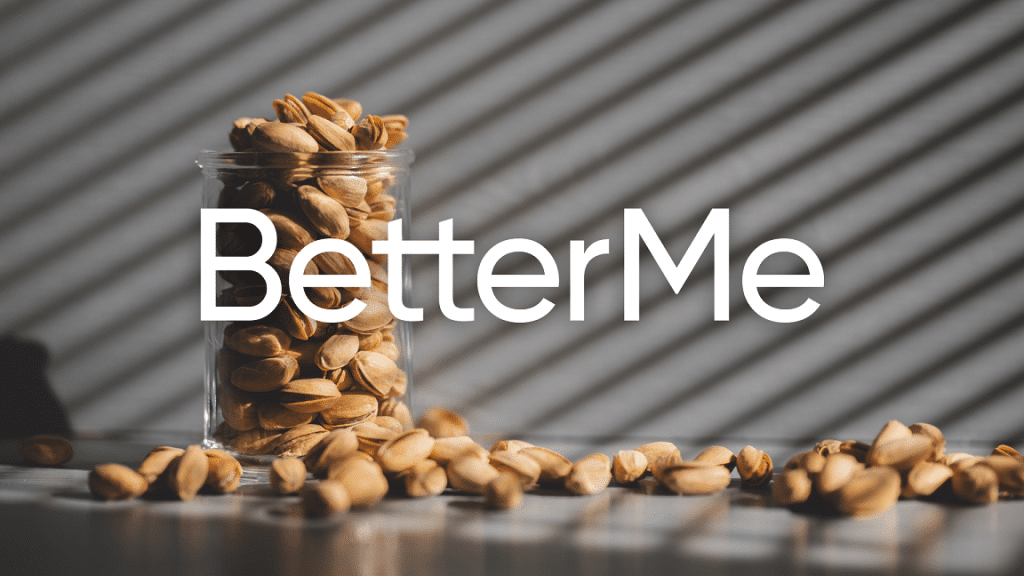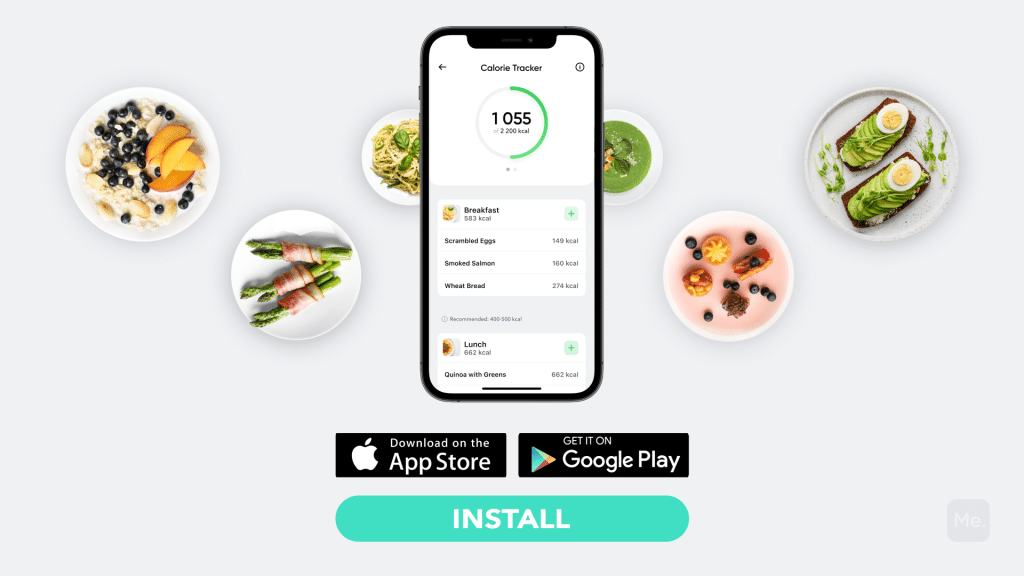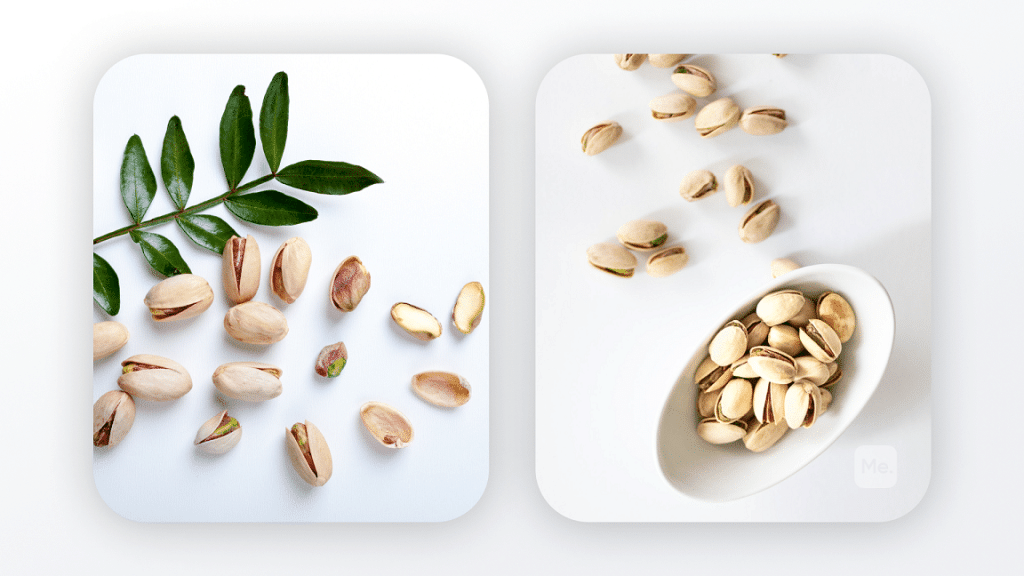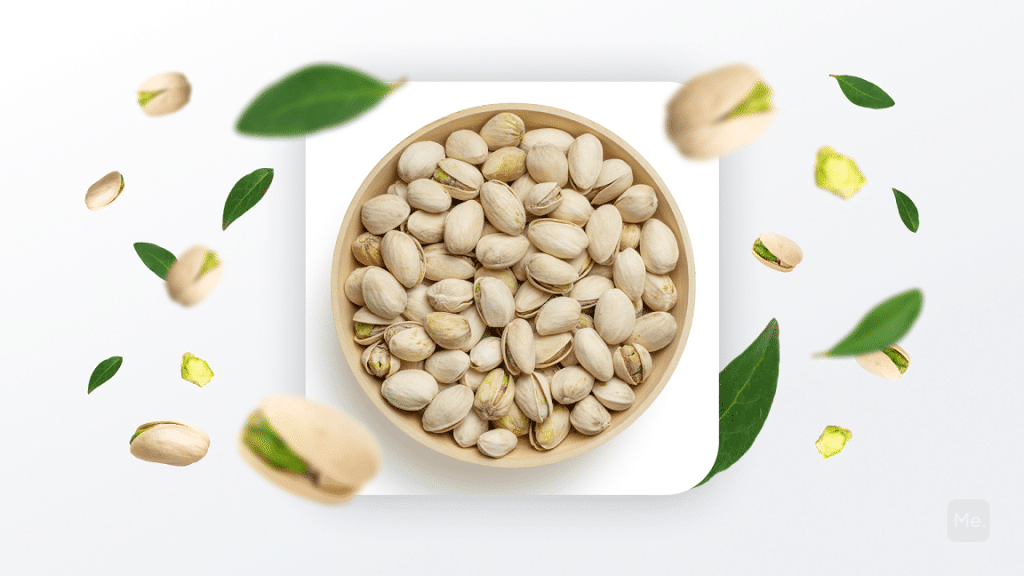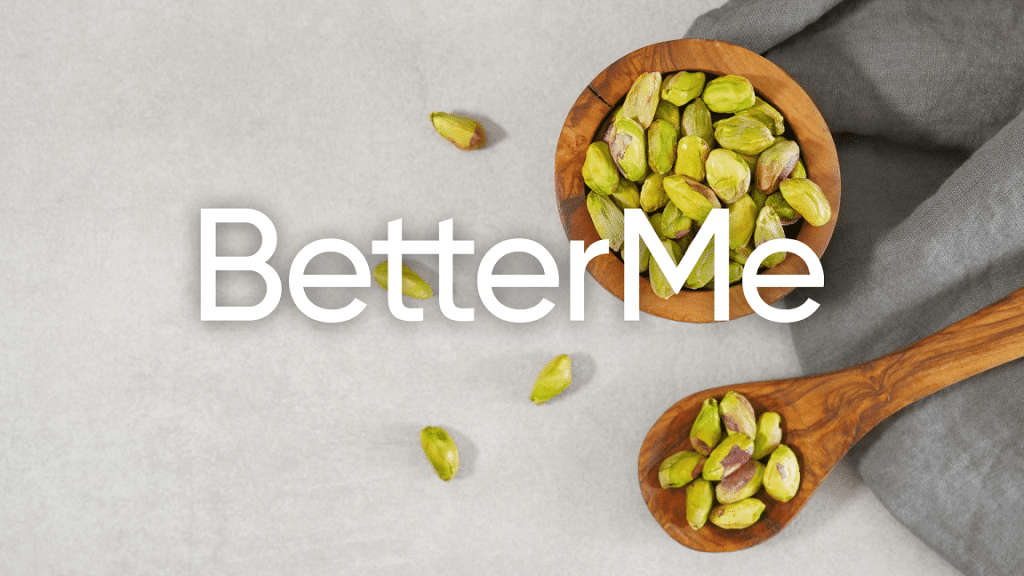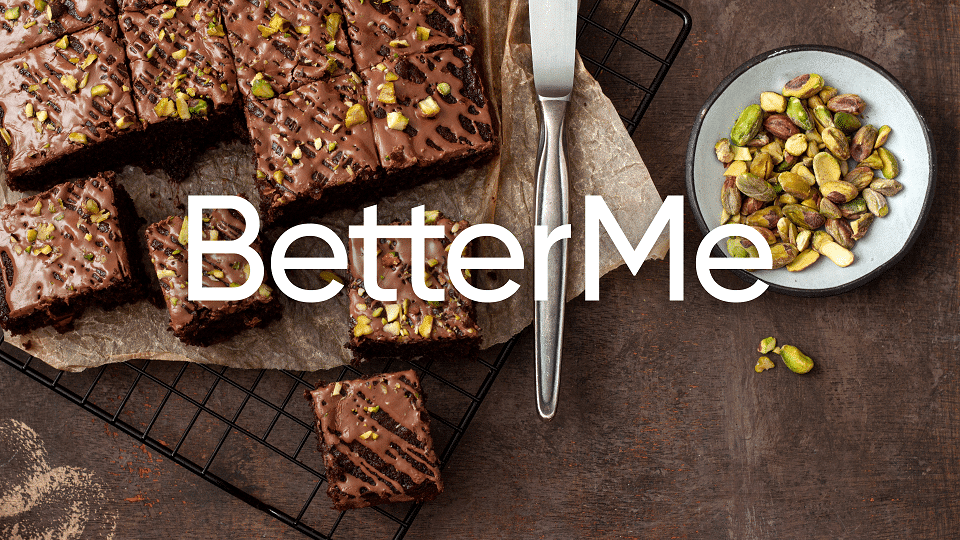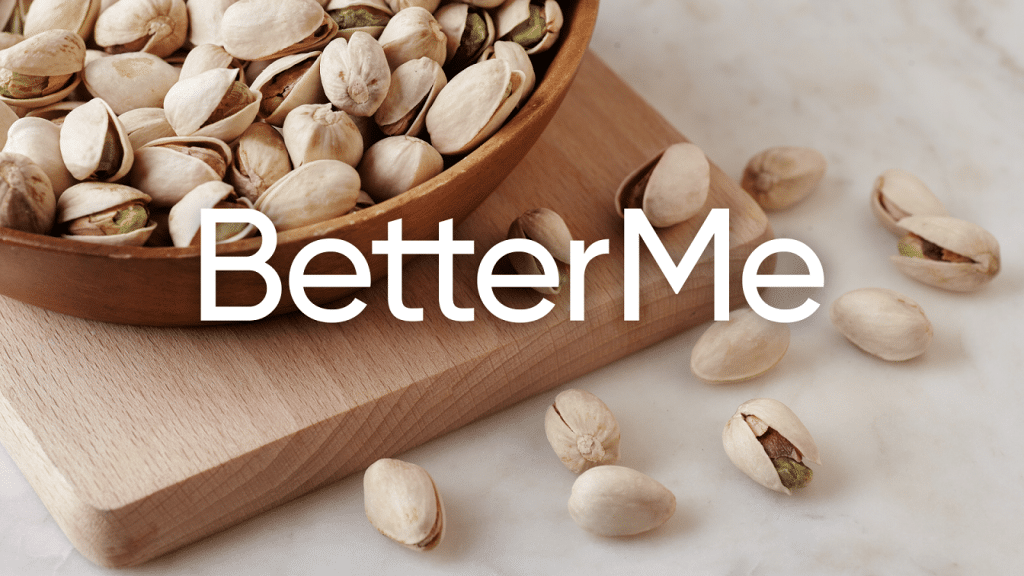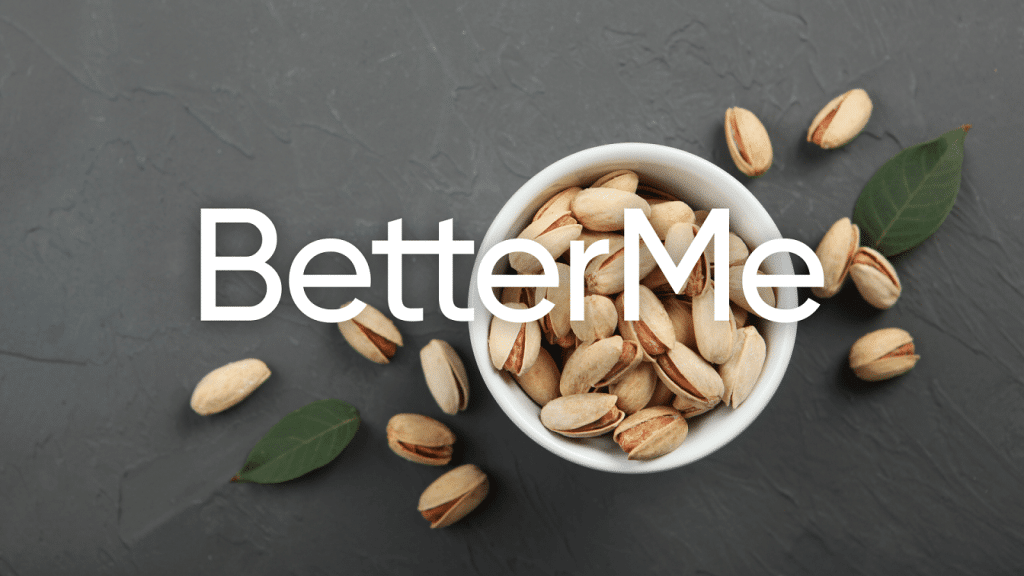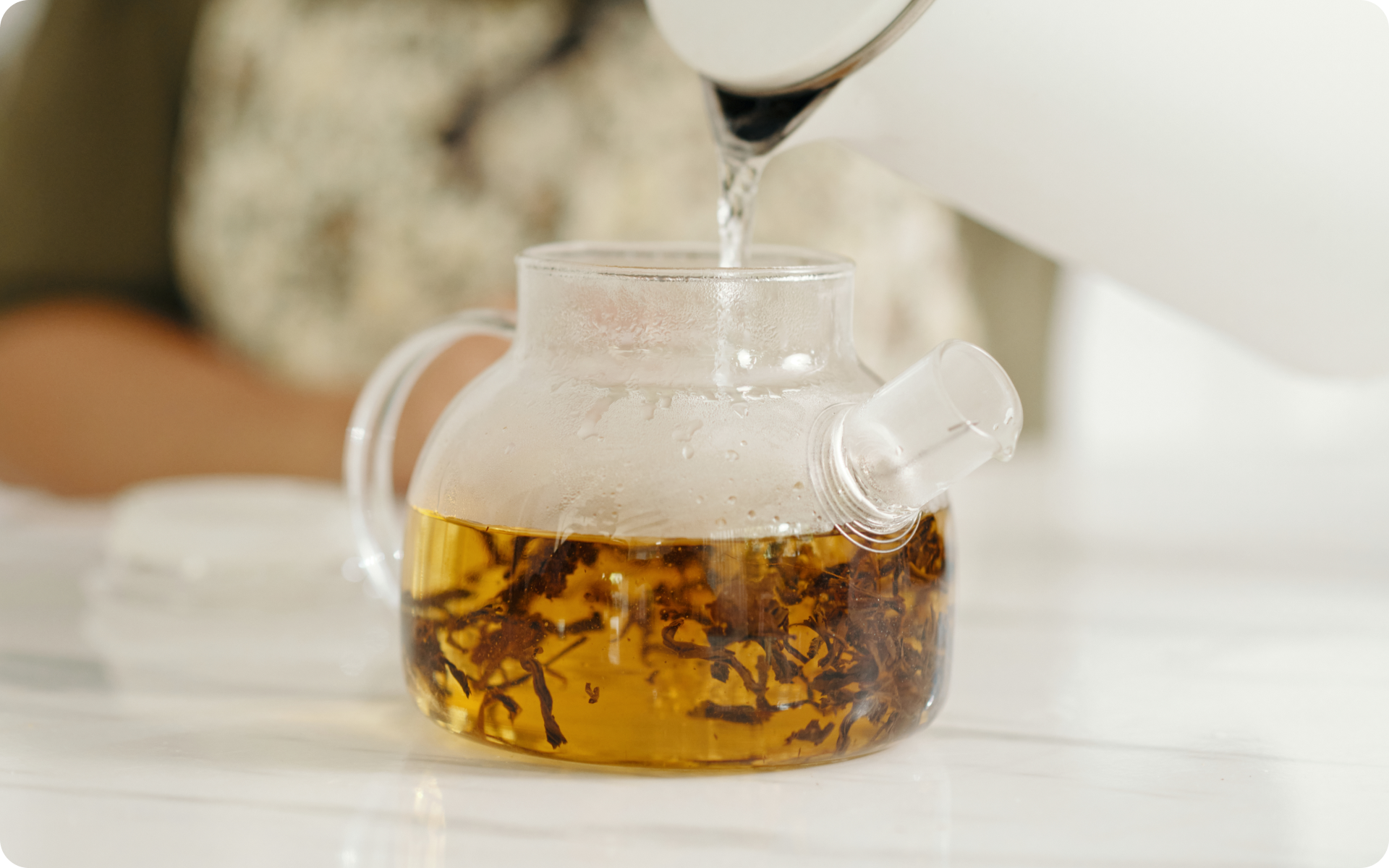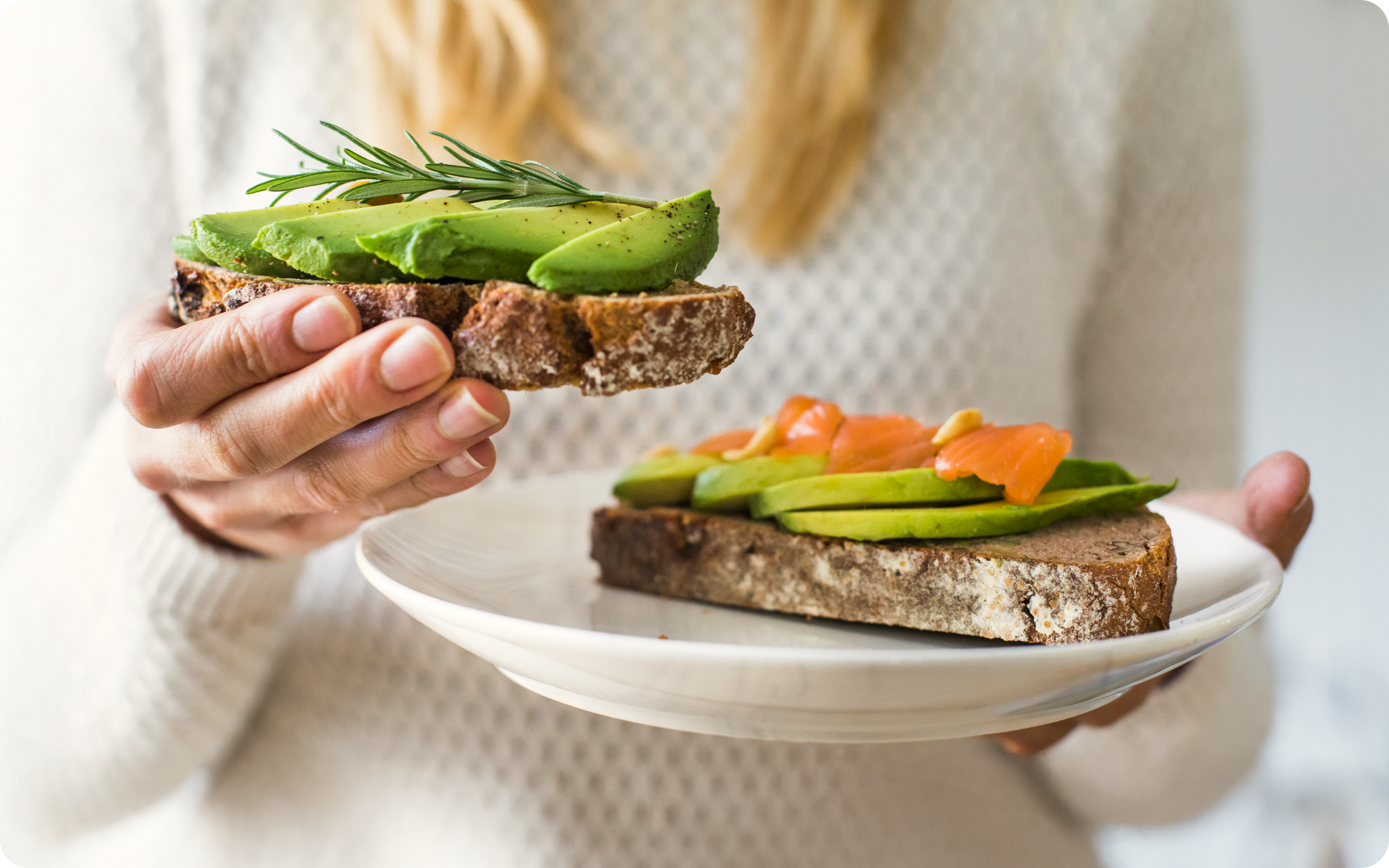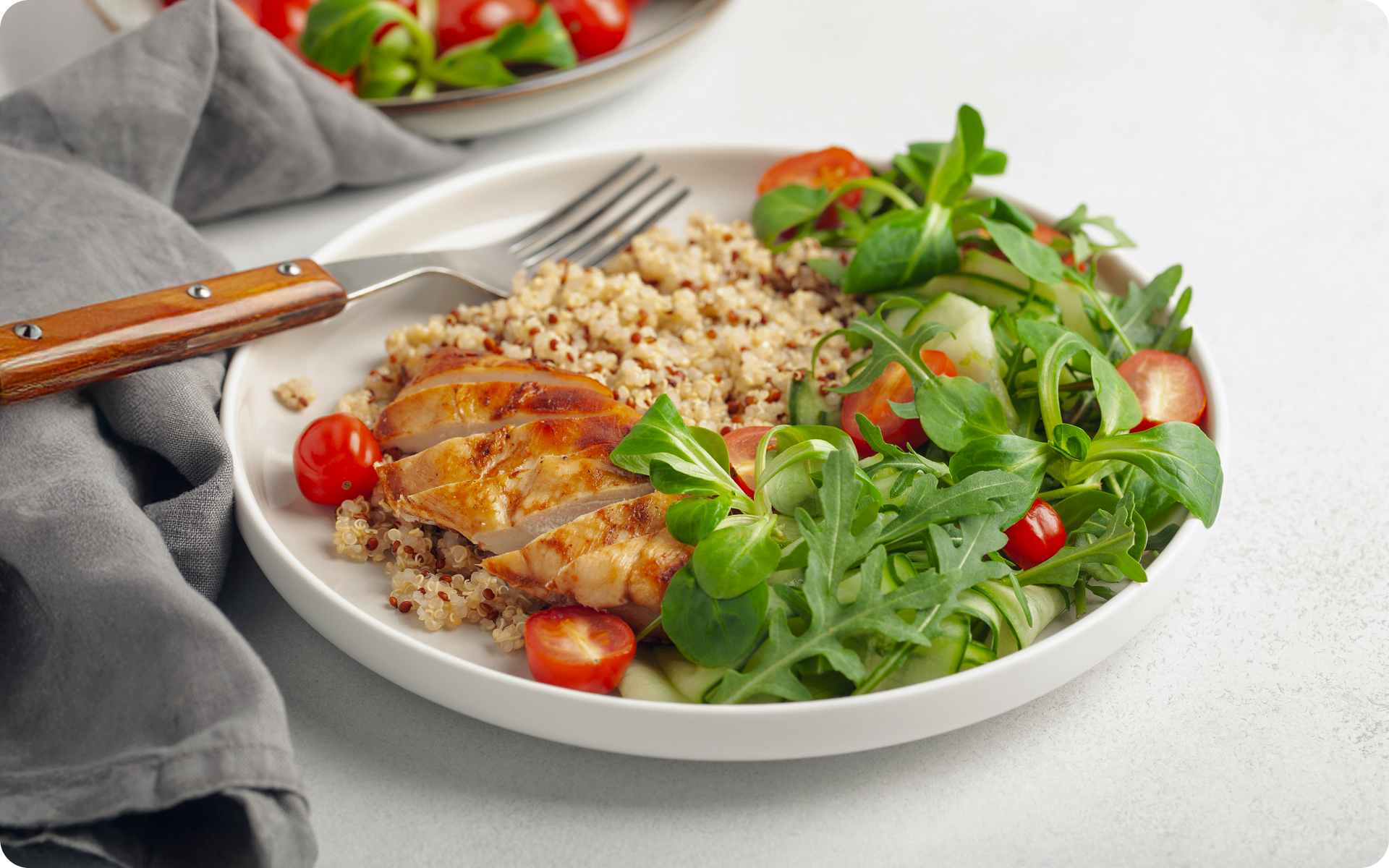Deciding what type of food to eat can be challenging when trying to maintain or lose weight. There is a common misconception that if you want to lose weight, it’s best to avoid all fat. However, there are healthy and unhealthy fats. While unhealthy fats may promote weight gain, healthy fats can actually result in weight loss. A great example of this would be the healthy fats in pistachios and other nuts. This article will explore everything about pistachios and belly fat and why pistachios are helpful for weight loss. We’ll also look at the different ways you can enjoy these nuts and give some healthy recipes that should make it to your weight loss meal plan.
Pistachios Nutrition Profile
What are in these nuts? According to the USDA, pistachios contain the following nutrients (per 1 oz serving, or around 49 kernels) (19):
- Calories: 159
- Protein (g): 6
- Fat (g): 13
- Carbs (g): 8
- Fiber (g): 3
- Sugars (g): 2
- Calcium (mg): 30
- Iron (mg): 1
- Magnesium (mg): 34
- Phosphorus (mg): 139
- Potassium (mg): 289
- Zinc (mg): 0.6
- Copper (mg): 0.4
- Manganese (mg): 0.3
- Lutein & zeaxanthin (mcg): 822
- Vitamin E (mg): 0.8
- Saturated fatty acids (g): 1.7
- Monounsaturated fatty acids (g): 6.6
- Polyunsaturated fatty acids (g): 4
Each of these nutrients has more health benefits, which will be expounded on in this article.
Read More: Pistachios Facts, Calories, Health Benefits And Side Effects
Pistachio Calories
A 1 ounce serving of pistachios has 159 calories (19). This is a great amount of calories for a snack, especially if you stick to the recommended serving size. For a relatively small number of calories, you get protein, healthy fat, and fiber, all of which can help you feel satisfied and make it to the next meal without additional snacks or feeling so ravenous that you overeat at the next meal.
Protein
A 1 ounce serving of pistachio offers about 6 grams of protein. This is great for weight loss because it promotes satiety and keeps you full. When you feel full, you’re less likely to snack on foods that can sabotage your weight loss goals, such as junk food and other high-calorie items.
Protein is also important for muscle synthesis and repair, so this makes pistachios a great snack option when you’re building muscle or losing weight (8). It also helps balance blood sugar levels after eating carbs, so it works well as a snack option before or after an intense workout.
Healthy Fats
Pistachio nuts contain 13 grams of fat per 1 ounce serving. This may be something to consider when watching your daily fat intake, but, again, the key here is moderation.
The fats found in pistachios are mostly monounsaturated, which is the “good” fat. These fats help lower your LDL and raise your HDL cholesterol. They also may help decrease triglyceride levels (1).
The benefits of these fats go beyond simply helping weight loss; they can help reduce the risk of cardiovascular disease, diabetes, and metabolic syndrome. Pistachios also have polyunsaturated fats, which may also help to control blood sugar levels (1).
Pistachio nuts are also high in Omega-3 fatty acids, which can help to decrease inflammation.
Carbohydrates
One serving of pistachios contains 8 grams of carbohydrates, 3 of which are fiber. Fiber is good for curbing appetite and controlling the glycemic index of other foods that are consumed at the same time (11).
BetterMe app will provide you with a host of fat-frying fitness routines that’ll scare the extra pounds away and turn your body into a masterpiece! Get your life moving in the right direction with BetterMe!
Fiber
Pistachios are also rich in fiber, with 3 grams per 1 ounce serving. This is not only good for digestive health but may also help you lose weight since it slows down digestion and keeps blood sugar levels stable between meals. Studies have shown that diets high in fiber promote fullness and lead to weight loss when consumed regularly (11).
Sugars
Pistachios are fairly low in sugars, with about 2 grams per 1 ounce serving. This makes them great for people watching their sugar intake but still love the rich taste.
Calcium
With 30 milligrams of calcium per 1 ounce serving, pistachios are a good source of this electrolyte, which is needed to build and maintain bone mass. It also helps promote muscle contraction and blood clotting (5).
Iron
Pistachio nuts contain about 1 milligram of iron per 1 ounce serving. Iron deficiency can lead to anemia, which results in fatigue and difficulty concentrating, among other things (15). So getting enough iron in your diet, as you would get from pistachios, is important to maintain healthy levels of hemoglobin.
Magnesium
Pistachios provide 34 milligrams of magnesium per 1 ounce serving. Magnesium is needed for building and maintaining bone mass, regulating blood sugar levels and blood pressure, creating energy in the body, stimulating metabolism, and promoting muscle relaxation (17).
Phosphorus
Phosphorus is an electrolyte that helps build bones and repair them when broken down. It also regulates blood sugar levels, among other functions it performs in the body (20).
Read More: What Is The Best Nut For Weight Loss: Lose Belly Fat And Those Extra Pounds
Manganese
Pistachio nuts are also rich in manganese, which is an essential mineral needed to produce energy, support brain functions, and help the body maintain proper blood sugar levels (18). It’s found mostly in whole grains, so pistachios can serve as a great alternative when you’re craving sweets or other sugary snacks.
Zinc
Pistachios provide 0.6 milligrams of zinc per 1 ounce serving. Zinc helps repair tissue damage, maintain bone health, regulate hormone production, among other important functions it performs to keep the body healthy (21).
Copper
These nuts also contain copper, which helps promote good bone health by strengthening connective tissues such as collagen and elastin. It is also needed for proper iron levels and hair growth (7).
Antioxidants
Pistachio nuts contain high amounts of antioxidants such as vitamin E and manganese, which aid the body in fighting free radicals that can cause damage to cells and tissues – leading to chronic diseases like cancer and heart disease (3). They’re one of the many plant-based sources of antioxidants out there, so be sure to include them in your daily diet for maximum health benefits.
Phytosterols
These substances exist in nuts like pistachios and may inhibit cholesterol absorption from the small intestine. Cholesterol is broken down into bile acids, and they’re sent back to the small intestine for re-absorption instead of being used to produce more cholesterol.
The fat found in pistachios may also increase the production of bile acids, which will help reduce your risk for heart disease and atherosclerosis (6).
Flavonoids
These substances can help prevent oxidative stress from free radicals (10). Although the science is still out on how effective flavonoids are at fighting free radicals, it can’t hurt to eat pistachios because they’re a good source of fiber and vitamin C.
Potassium
Pistachios are rich in potassium, which helps balance fluids inside the cell. It also regulates blood pressure, among other functions it performs to keep muscles healthy, including those found in our hearts (9).
Muscle health is imperative for weight loss since the more lean muscle mass we have, the more calories we burn (14). This is especially important for women since they naturally have less muscle than men, so it’s harder for them to lose weight and keep body fat low.
B-Vitamins
Pistachio nuts provide a good amount of B-vitamins, which help maintain healthy levels of energy by converting food into glucose that is used as fuel by cells and tissues to produce our daily energy needs.
B-complex vitamins in pistachios also help metabolize the fats and carbs that you eat as well as keep your body hydrated (4). If you’re thinking of hitting the gym to lose some belly fat, these nuts are a perfect addition to your diet.
Sodium
Even though pistachios contain sodium, particularly if they are salted, they’re still considered healthy because most people don’t need to limit their intake as much as they need to with unhealthy snacks, such as chips and other processed foods. The amount of sodium present in pistachio nuts is mostly offset by the high levels of potassium.
BetterMe will keep you laser-focused on your weight loss journey! Nutrient-packed meal plans, fat-blasting workouts, galvanizing challenges and much more. Try using the app and see for yourself!
How To Eat Pistachios For Weight Loss?
The best way to eat pistachios for weight loss is by having a small amount every day.
Here are some ways to incorporate these delicious nuts into your meals:
Mixing Them Into Yogurt
Yogurt is a high-protein, low-fat food that makes a good choice for snacks. Simply put a handful of pistachios into your cup of yogurt to get a great mixture of flavors and textures.
Snacking On Them Raw
This is a perfect combination that you can eat as an afternoon snack or get yourself through your mid-morning hunger pangs. Just remember not to overdo it since nuts like pistachios are high in calories and fat if you go overboard with your portion size (12).
Making Pistachio Butter
This tasty spread can be used in place of peanut butter or Nutella on toast or even as an alternative to sour cream or mayonnaise on baked potatoes.
Eating Them Roasted
Roasting pistachios makes their flavor more intense and changes their texture, so they’re easier to chew. Get yourself a bag of roasted pistachio nuts, mix them with your favorite dried fruit, such as cranberries or apricots, and you’ll have a truly healthy snack that’s perfect for your weight loss regime.
When buying roasted pistachios, you have to consider if they are roasted in oil or without it. Better yet, you can roast your nuts yourself the healthy way by using little to no oil at all.
Also, look into the amount of salt used for roasting the nuts because some brands tend to use a lot of it, which can offset some of the other health benefits you get from this powerful nut. Sodium is notorious for water retention that leads to bloating, so always opt for the brands with the lowest amount of sodium possible, or unsalted if you can find them (13).
Topping For Salad
Since pistachios are high in healthy fats, they make a wonderful addition to salads. You can get creative with your salad toppings and come up with interesting combinations using this versatile nut.
You can even try sprinkling some of these nuts on top of green bean dishes for an added crunch. Other great ideas include adding them to sesame noodles and stir-fry vegetables.
Baking It As Vegan Treats
Nothing gives vegan pastries a much-needed protein boost like pistachios. Try them out in your favorite vegan cookie recipes for a truly unique taste. Tunisian recipes, for example, often call for pistachios, especially in dessert dishes like baklava.
A Note About Belly Fat
Losing belly fat requires more than just switching from unhealthy, processed snacks to healthy, nutrient-packed ones like pistachios. You need a well-balanced diet that’s customized to create a calorie deficit.
You also need to increase the amount of physical activity you do every day (16).
Here are some quick tips for losing belly fat:
Don’t Overeat Or Undereat
While you want to reduce your calorie consumption to lose weight or prevent weight gain, you have to be careful not to turn to extremely restrictive dieting, which can backfire.
Always Keep Physical Activity In Mind
While you might see some quick changes in your physique when you stick to a restricted-calorie diet, the true results will show themselves through exercise.
Consider Balancing Your Hormones
Hormonal imbalances often lead to weight gain in your midsection (2). Work with your doctor to ensure you’re getting the right nutrition and using natural remedies like exercise to turn things around.
Add Resistance Training
This doesn’t mean hopping on the treadmill at high intensity; instead, it involves lifting weights, using your body weight for resistance, or both.
The Bottom Line
Pistachio nuts are a great addition to your diet, especially if you want to be healthy and maintain a lean figure. However, moderation is key. Stick with a reasonable portion per day as part of your balanced meal plan.
Remember that all the aforementioned health benefits come from raw or dry-roasted pistachios, not oil-roasted and heavily salted ones, which often contain added sugars and unhealthy ingredients such as hydrogenated oils (trans fats). So read labels carefully when shopping for these nutritious nuts if possible, so you know what’s going into your body.
Get your personalized
meal plan!
DISCLAIMER:
This article is intended for general informational purposes only and does not address individual circumstances. It is not a substitute for professional advice or help and should not be relied on to make decisions of any kind. Any action you take upon the information presented in this article is strictly at your own risk and responsibility!
SOURCES:
- A healthy approach to dietary fats: understanding the science and taking action to reduce consumer confusion – Nutrition Journal (2017, nutritionj.biomedcentral.com)
- Altered gut and adipose tissue hormones in overweight and obese individuals: cause or consequence? | International Journal of Obesity (2015, nature.com)
- Antioxidants in human health and disease (1996, pubmed.ncbi.nlm.nih.gov)
- B Vitamins and Their Role in Immune Regulation and Cancer (2020, mdpi.com)
- Calcium Intake and Health (2019, mdpi.com)
- Cholesterol, hydroxycholesterols, and bile acids (2002, pubmed.ncbi.nlm.nih.gov)
- Copper – Health Professional Fact Sheet (2021, ods.od.nih.gov)
- Dietary Protein and Muscle Mass: Translating Science to Application and Health Benefit (2019, mdpi.com)
- Electrolytes (2021, pubmed.ncbi.nlm.nih.gov)
- Flavonoids: an overview (2016, cambridge.org)
- Health benefits of dietary fiber (2009, academic.oup.com)
- Health Benefits of Nut Consumption (2010,mdpi.com)
- Increased salt consumption induces body water conservation and decreases fluid intake (2017, ncbi.nlm.nih.gov)
- Increasing muscle mass to improve metabolism (2013, tandfonline.com)
- Iron Deficiency Anemia – StatPearls (2021, ncbi.nlm.nih.gov)
- Losing Weight | Healthy Weight, Nutrition, and Physical Activity (2020, cdc.gov)
- Magnesium and Human Health: Perspectives and Research Directions (2018, hindawi.com)
- Manganese in Health and Disease (2019, ncbi.nlm.nih.gov)
- Nuts, pistachio nuts, raw (2019, fdc.nal.usda.gov)
- Phosphorus (2015, academic.oup.com)
- Zinc and its importance for human health: An integrative review (2013, ncbi.nlm.nih.gov)
